
The Nile River contains a vast assortment of snakes.
©River Nile, Luxor, Egypt/Shutterstock.com
The Ancient Egyptians both feared and honored the many species of snakes that lived by the Nile River. Snakes were terrifying because they could strike unexpectedly and even kill. However, they also kept rodents out of the Egyptian’s grain storage. The god Apep or Apophis, the enemy to order, was represented by a giant snake of chaos. On the other hand, snakes were also seen as a sign of power and protection for Egyptian royalty. The pharaoh’s crown or diadem was decorated with a golden hooded cobra.
Many of the snakes of Ancient Egypt still slither along the banks of the Nile River today, from the cobras of the pharaohs to small but deadly vipers. Let’s take a closer look at 12 snakes that live by the Nile!
1. Egyptian Cobra
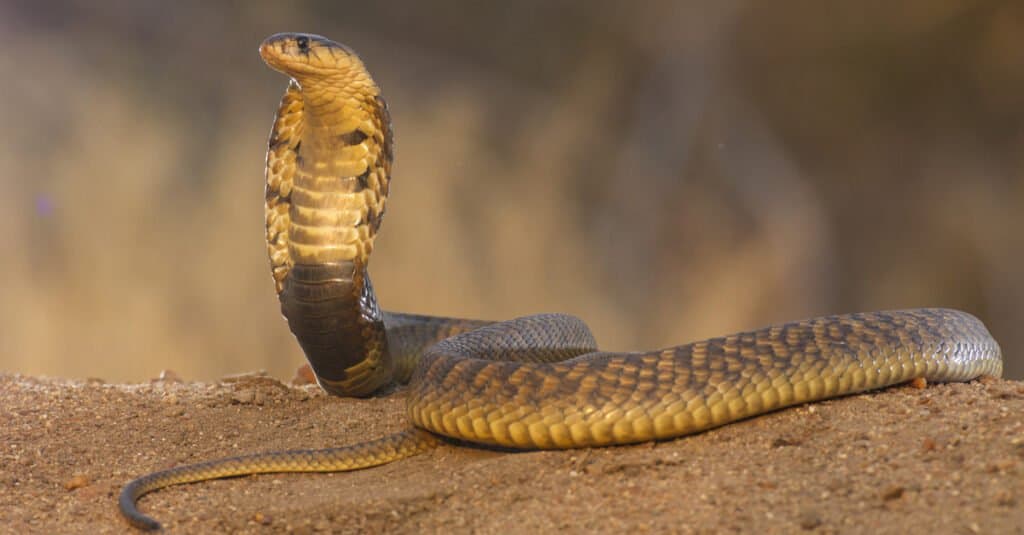
Egyptian cobras live by the Nile and can weigh up to 20 lbs.
©Stu Porter/Shutterstock.com
The Ancient Egyptians respected the Egyptian Cobra as a symbol of the Pharaoh and his sovereignty. This large and iconic cobra usually grows between 4-5 feet, although the largest recorded was over eight feet long! Egyptian cobras come in various shades of brown (yellowish-brown, copper-red-brown, grey-brown, dark brown, etc.). However, snakes in northwestern Africa can be almost completely black.
They often live near water, but can also be found in savannahs, semi-deserts, scrub vegetation, steppes, agricultural fields, and even villages where they hunt rats and chickens. The Egyptian cobra is one of the most venomous snakes in North Africa, with a potent neurotoxic and cytotoxic venom.
2. Red Spitting Cobra
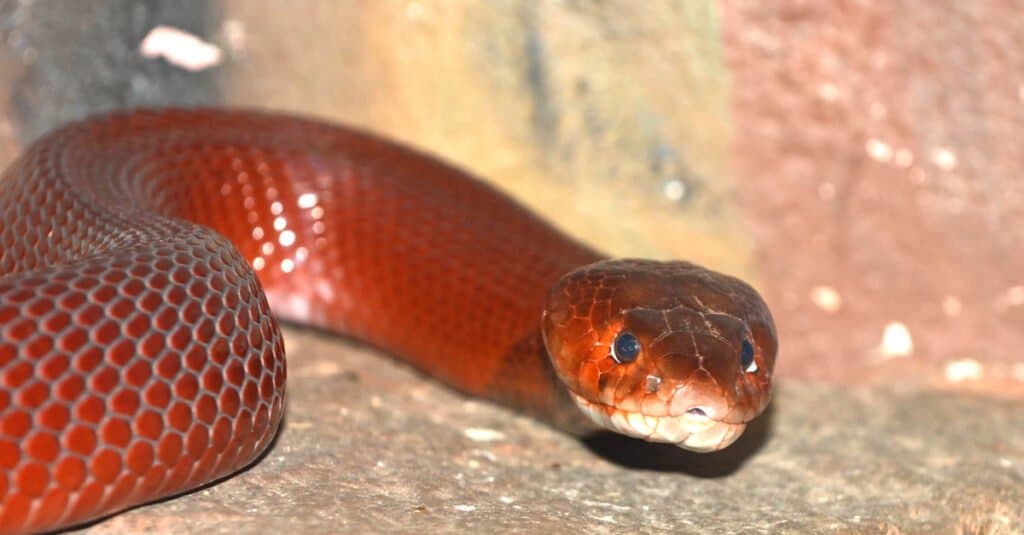
Red spitting cobras are distinguished from other snakes within the genus
Najaby the single, thick dark band around their necks and throats.
©mountainpix/Shutterstock.com
The Red Spitting Cobra not only injects venom into its bite, but it can spit it straight into the eyes of an attacker! In fact, this snake has expert aim and almost never misses its target. Spitting cobras squeeze the muscles around their venom glands to force a focused stream of venom through a small hole in their front fangs. The venom has a chemical composition that burns the cornea of the eye and can cause permanent blindness. These snakes are typically between 2-4 feet with vivid red bodies and a black band around their throats.
3. Horned Viper
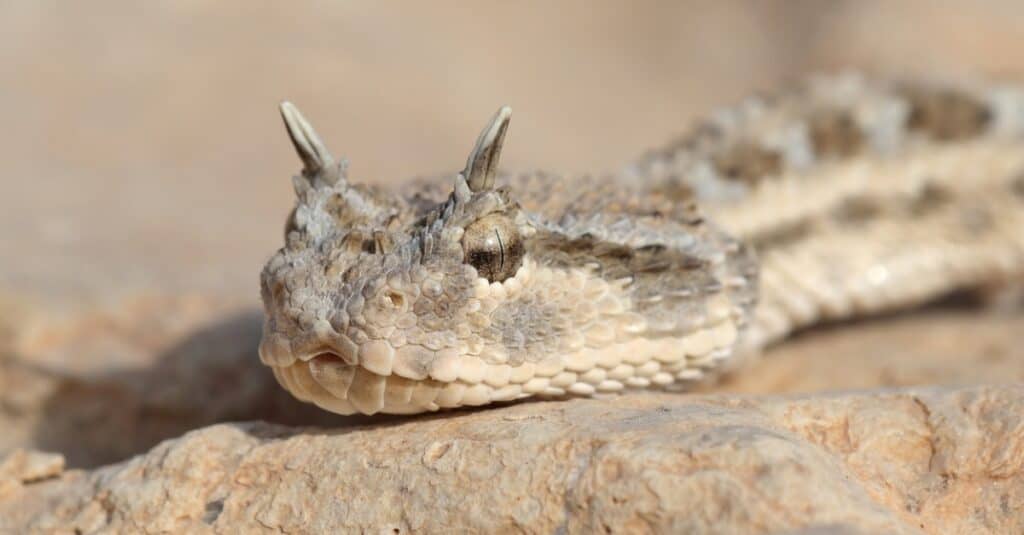
The horns over the eyes are the most distinctive feature of the horned viper.
©iStock.com/bogdanhoria
Horned Vipers get their name from the unique horn-like scales protruding above their eyes. These snakes are not as toxic as many other snakes that live by the Nile. However, they were feared by the Ancient Egyptians because of their venomous bite and expert camouflage skills. Their bodies are the same color as the sand or substrate of their environment, often with grays, pinks, reds, yellows, pale browns, and dark blotches. Their colors help horned vipers remain undetected when buried in sand waiting to ambush prey.
Unfortunately, this also makes it easy for an unsuspecting human to accidentally step on an apparently invisible horned viper buried beneath the sand. In addition, horned vipers are not very big, growing only between 12-24 inches in length.
4. African Egg-Eating Snake

African egg-eating snake, Dasypeltis scabra, coiled on the ground.
©Joe McDonald/Shutterstock.com
African Egg-Eating Snakes are uniquely adapted to eat a diet of only eggs! These snakes have uniquely hinged jaws that allow them to swallow eggs whole, some as large as chicken eggs. In addition, they have unique spines and bony projections along their esophagus that crack and crush the egg, squeezing out the contents before the snake regurgitates the eggshell. They live in trees where they hunt for bird eggs, mainly in the southern Nile Valley as well as parts of Arabia and Africa.
5. Black Mamba
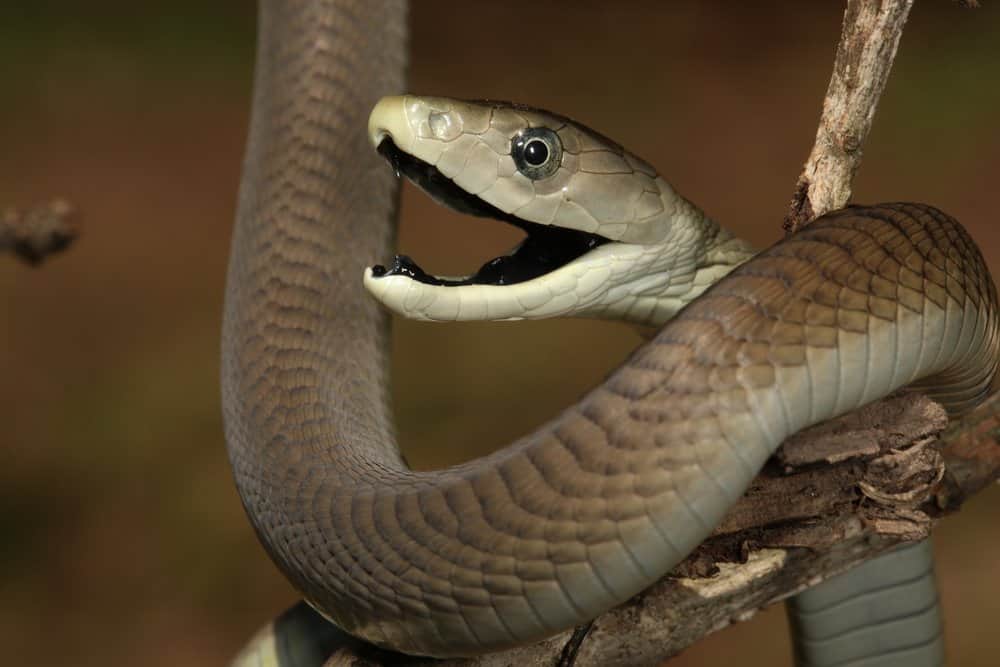
Black mambas are rarely black, and they’re actually named for the inside of their mouth.
©NickEvansKZN/Shutterstock.com
The black mamba is infamous for being one of the deadliest venomous snakes in the world and is often blamed for all kinds of mysterious deaths in Africa. This snake can grow up to eight feet long with a silvery-grey body. Although they are incredibly dangerous, black mambas are shy snakes that try to escape when they encounter danger.
However, if a black mamba feels threatened, it can raise 1/3 of its grey body off the ground and open its mouth wide as it hisses. The interior of the snake’s mouth is a dark blue-black color, which is where it gets its name from. If the threat continues, the black mamba will repeatedly strike with large amounts of venom. The venom of a black mamba snake contains cardiotoxins and hemotoxins and is 100% fatal without antivenom. In fact, before antivenom was created for this snake, human victims died within 20 minutes.
6. Green Mamba

Western green mambas (D. viridis) inhabit coastal rainforests in West
Africa
.
©Sibons photography/Shutterstock.com
The green mamba is another extremely venomous snake that lives in trees along the southern portions of the Nile River. This snake is typically 6.5 feet long with a slender body. Like their name, green mambas have vivid green colors that allow them to blend in seamlessly with the trees in their arboreal habitats.
In addition to this powerful camouflage, these snakes are elusive and shy, so they are rarely seen. Green mambas have a powerful venom with cardiotoxins and neurotoxins that affect the nerves and the brain. However, if they have the option, green mambas will try to escape when they see a human rather than attack or strike. These snakes are ambush predators that eat birds, eggs, bats, and rodents.
7. Dice Water Snake
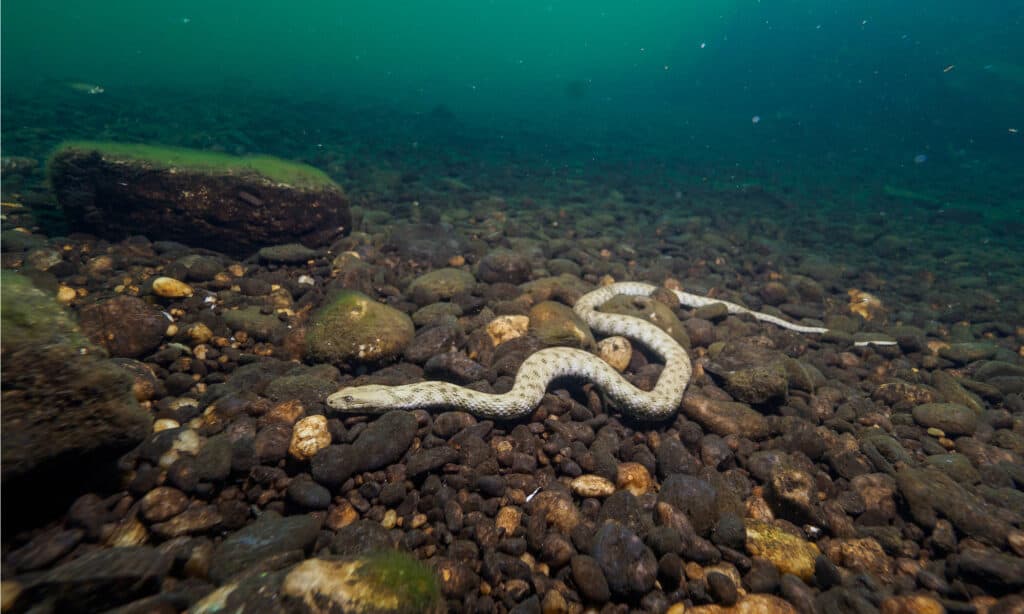
Dice water snakes live almost exclusively in water.
©benny337/Shutterstock.com
The dice water snake lives almost its entire life in water and can be found in the lower Nile Valley and Nile River Delta. These snakes are nonvenomous snakes that eat invertebrates, frogs, tadpoles, toads, and fish. When they feel threatened, dice water snakes secrete a foul-smelling odor, or they may even play dead.
Dice water snakes are between 40-50 inches long with grey-green, brown, or brown-black bodies and dark spots along their backs. Their bellies are often brightly colored in orange or yellow, along with black dots that look like game dice. Between March and May, large groups of snakes gather in the river to mate, and babies hatch in early September.
8. Saw-Scaled Viper
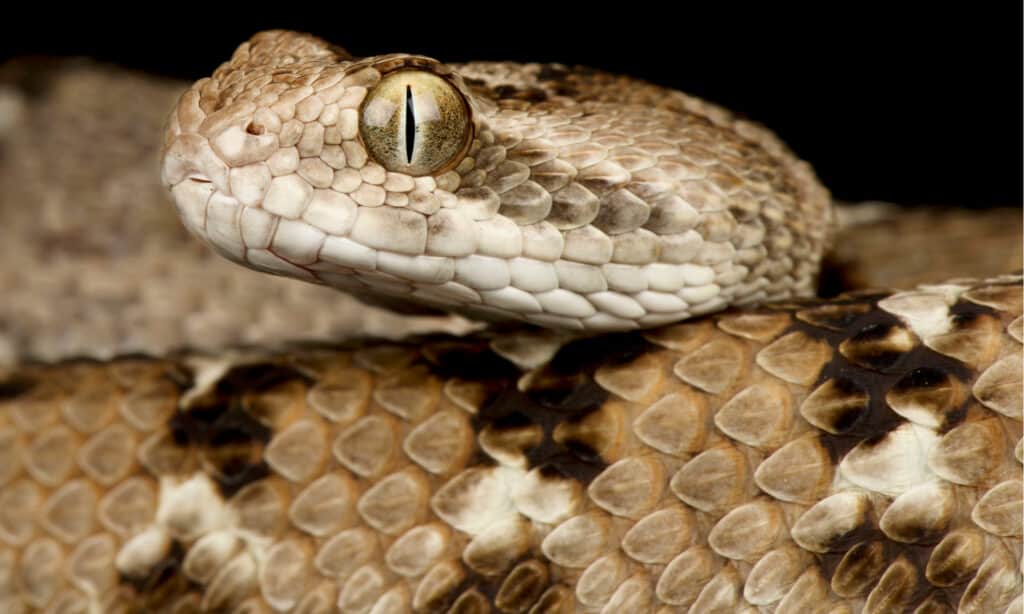
When a saw-scaled viper rubs its keeled scales together, it produces a sound like water sizzling on a hot pan or a loud saw.
©reptiles4all/Shutterstock.com
The saw-scaled viper lives in Egypt, Africa, and the Middle East. Although it is usually not more than 3 feet long, it is one of the most venomous snakes in Egypt. Unlike many of the snakes on this list, saw-scaled vipers are very aggressive and do not hesitate to strike. However, these snakes are mostly nocturnal. When they feel threatened, saw-scaled vipers rub their scales together to make a loud warning sound, which is where they get their name from. At least two of the twelve species of saw-scaled vipers live near the Nile River: the Egyptian saw-scaled viper, and the painted saw-scaled viper.
9. Egyptian Hissing Sand Snake

Egyptian Hissing Sand Snakes generally slither along the sand and grassy areas along river banks, but can sometimes be found on low bushes as well.
©reptiles4all/Shutterstock.com
The Egyptian hissing sand snake lives in the Nile River Valley. These snakes commonly live along the banks of rivers, streams, and canals, where they hunt lizards, frogs, mice, and small snakes. Egyptian hissing sand snakes have slender brown or yellowish bodies that can grow up to 55 inches. They also have longitudinal brown-gray and yellowish stripes along their sides like a garter snake. Their venom is mildly toxic and not usually fatal to humans, usually only causing some inflammation near the bite.
10. Egyptian Sand Boa
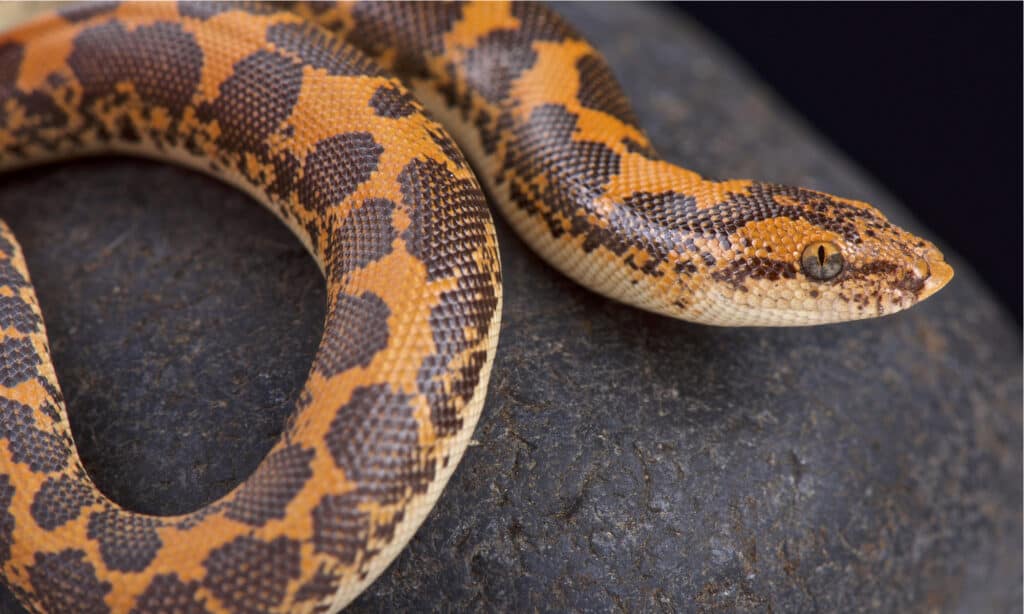
Egyptian sand boas (Gongylophis colubrinus) are docile snakes with striking colors and are often kept as pets.
©reptiles4all/Shutterstock.com
The Egyptian sand boa often hunts along the sandy banks of the Nile River as it lies in wait for potential prey animals to pass by. This snake has a thick body that grows between 12-24 inches with a small head and short tail. Egyptian sand boas have a bold and striking appearance, with heavy orange or yellow bodies and dark brown splotches along their backs.
These snakes are constrictors that squeeze their prey until they stop breathing. They are generally active at night and spend most of their time underground, although they are skilled at climbing trees. Because Egyptian sand boas do not grow more than 36 inches at most and are very docile snakes, they have also become popular pets.
11. Saharan Sand Viper

The color of the sand viper helps it to blend in with its habitat where it hunts for prey.
©reptiles4all/Shutterstock.com
The Saharan sand viper is a small snake, measuring between 11-20 inches long. It is sometimes called an Egyptian Asp or Cleopatra’s Asp as well, and some believe that this snake may have been the species that Cleopatra used to kill herself. They have large, triangular-shaped heads, and bodies that reflect the color of their sandy desert environment. They can be tan, brown, beige, reddish brown, or dark brown, with large dark blotches along their backs and smaller spots along their sides. The end of their tails is very thin, and often tipped in black.
Saharan sand vipers have heavily keeled scales that give their bodies a bristly texture. They are nocturnal snakes that hunt geckos and lizards at night. Saharan sand vipers bury themselves in the sand or hide under bushes during the day.
12. African Rock Python

Like all pythons, the African Rock Python is non-venomous. It kills by constriction, ambushing, and coiling around its prey.
©zaferkizilkaya/Shutterstock.com
The largest snake that lives by the Nile is the African rock python. These snakes can grow up to 20 feet in length, although on average they are usually 10-16 feet long. African rock pythons are beautifully patterned snakes with thick bodies. They are tan, brown, or brownish gray, with irregular dark blotches with black and white outlines along the length of their bodies.
African rock pythons are bold and powerful constrictors that have been known to swallow crocodiles and antelopes! However, they more commonly eat animals like monkeys, hyraxes, lizards, and game birds. These snakes love water and commonly hide in dense vegetation along the banks of rivers and marshes. They are not typically aggressive, but they can scare easily and will bite if they are attacked or threatened.
Summary Of The 12 Snakes That Live by the Nile
| # | Snake | Venomous or Non-Venomous |
|---|---|---|
| 1 | Egyptian Cobra | Venomous |
| 2 | Red Spitting Cobra | Venomous |
| 3 | Horned Viper | Venomous |
| 4 | African Egg-Eating Snake | Non-venomous |
| 5 | Black Mamba | Venomous |
| 6 | Green Mamba | Venomous |
| 7 | Dice Water Snake | Non-venomous, will emit a foul odor |
| 8 | Saw-Scaled Viper | Venomous |
| 9 | Egyptian Hissing Sand Snake | Mildly Venomous, not to humans |
| 10 | Egyptian Sand Boa | Non-venomous but will constrict, rarely bites |
| 11 | Saharan Sand Viper | Venomous |
| 12 | African Rock Python | Non-venomous but will bite and constrict |
Other Animals That Are Found Near The Nile

The goliath tigerfish (Hydrocynus goliath) is a very large African predatory freshwater fish found in the Congo River Basin.
©Danny Ye/Shutterstock.com
The African goliath tigerfish is a large predatory fish that can grow up to 4 feet and weigh between 90 to 100 pounds. Most species of tigerfish are not dangerous to humans, with the exception of this one – it is the only species of tigerfish that is known to actually attack humans. Each one of their massive teeth is one inch long and due to the force of their bites, they are able to cause considerable damage. Even though it is in a completely different family than the Piranha, it is considered to be Africa’s equivalent.
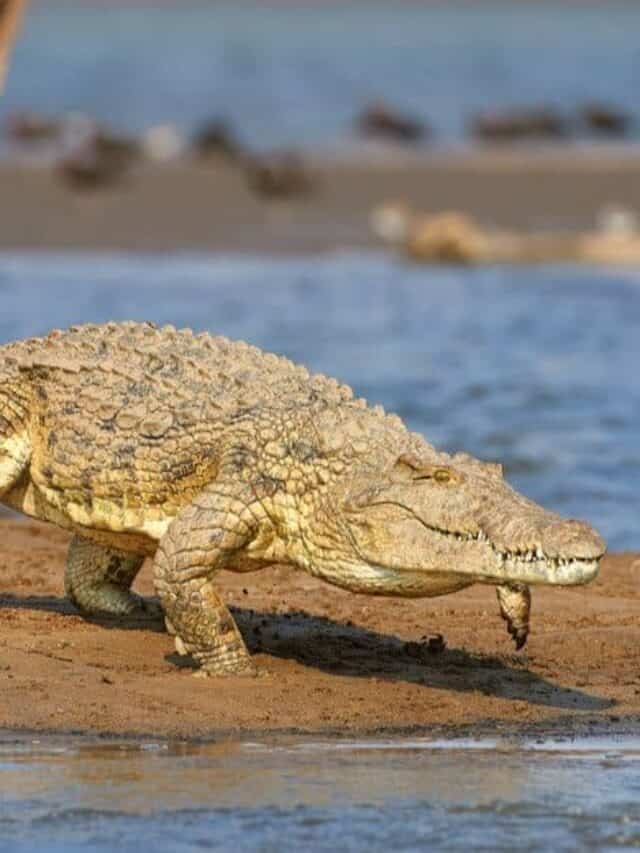
The Nile crocodile is the second largest crocodile in the world, with an average size of 900 pounds and a length of between 13 to 14.7 feet. Native to freshwater, this extremely aggressive reptile has no natural predators, except for humans, and is highly territorial, more so of the males. They patrol their territory, which extends from the shoreline to about 165 feet into the water, and should they feel threatened, are able to remain submerged for 30 minutes, although they are capable of holding their breath for up to two hours if completely still. While it may not seem like it, this crocodile not only has fast reflexes but is very fast not only on land but in the water.
Discover the "Monster" Snake 5X Bigger than an Anaconda
Every day A-Z Animals sends out some of the most incredible facts in the world from our free newsletter. Want to discover the 10 most beautiful snakes in the world, a "snake island" where you're never more than 3 feet from danger, or a "monster" snake 5X larger than an anaconda? Then sign up right now and you'll start receiving our daily newsletter absolutely free.
Thank you for reading! Have some feedback for us? Contact the AZ Animals editorial team.








